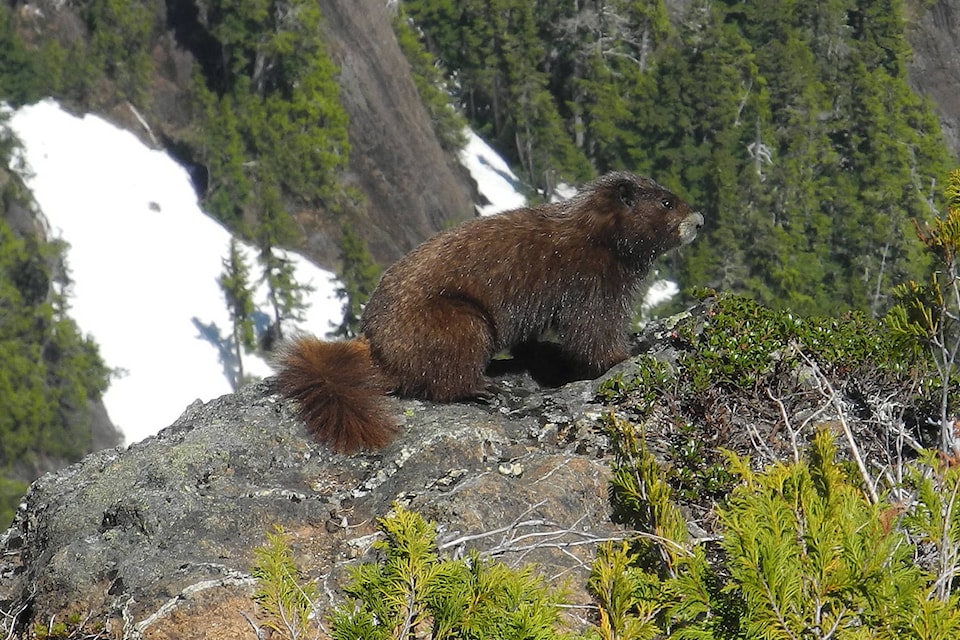SANDY MCRUER
SPECIAL TO THE NEWS
Alberni Valley hiking enthusiast, Laurie Morphet, was on a hike up Mount Arrowsmith in June when she encountered a Vancouver Island Marmot. She was excited to see this creature as it is the rarest endemic mammal in Canada.
A Vancouver Island marmot looks like what people in Ontario call a groundhog. In fact, this rodent is closely related. The ranges of other rare mammals in Canada also extend into the United States. This one is confined to the steep, high, subalpine slopes of Vancouver Island. So it is endemic to Canada.
Morphet discovered the marmot 15 kilometres southeast of Port Alberni on a very steep subalpine meadow called Grassy Mountain, which is just outside the city’s water supply, the China Creek drainage. Although it was known earlier by the general public, it was scientifically discovered in 1910 when a fellow called Harry Swarth discovered it there. He shot 12 specimens for the museum. Ironically, that was enough to wipe out the colony on Grassy Mountain. Fortunately there were several other colonies scattered between the high mountains west of Nanaimo and Strathcona Park.
They weren’t always rare. In fact, at the end of the last Ice Age 10,000 years ago, they were likely fairly common. They had recently made the trip across the Salish Sea, which was lower at that time, allowing marmots to reach the Island. At that time the forests were confined to the lowlands and consisted of open lodgepole pine. So there was lots and lots of habitat for them. But then everything warmed up and gradually the rainforests moved northward from Oregon and California, and upward to the tops of the smaller mountains. So the habitat for them shrank enormously.
The first people on Vancouver Island knew of them and hunted them. There are several old skeletons in museums with tell-tale cut marks on their bones. But it wasn’t them that brought their population into a long gradual decline. It was a changing climate.
This decline was accelerated when logging started to move higher into the mountains. A bunch of things happened. Individuals from colonies regularly disperse from one colony to another to mate. In doing that they found recent clearcut habitat that resembled their colonies and started to live in them. They died because the damp rather than dry winter conditions at lower elevations weren’t right for them. Added to that, predators were found to be changing their habits as well due to forestry activities. Predators are now the primary cause of mortality among Vancouver Island marmots.
The Vancouver Island Marmot Recovery Foundation has successfully been raising marmots in captivity and introducing them to existing colonies. When they started in 1997, there were only 70 marmots in the wild. Six years later that number was 30. Now, having learned a few things, the population is around 200 and they are scattered across 28 mountains. The goal of the foundation is to have 400-600 marmots in three different broad geographic areas—the mountains east of Nanaimo, the Forbidden Plateau/Mount Washington area and the mountains of Strathcona Park west of Buttle Lake. Further, these colonies should be self-sustaining.
READ: Marmot released on Mount Washington
READ: Special milestone for marmots on Mount Washington
The executive director of the Marmot Recovery Foundation, Adam Taylor, believes that the original colony disappeared during the 1990s. However he said that in 2007, one of the marmots released at a nearby mountain showed up on Arrowsmith. They moved some marmots from another location to support it and then released captive-bred marmots in 2009 and 2011.
“Since then the colony has persisted on its own,” Taylor says. Interestingly the marmots chose an area that is inaccessible on foot, that is, until this year. Now the colony is showing signs that is at or near capacity as there have been a number of reports of young marmots that have moved away from the colony. The foundation plans to do a more thorough inventory later in the summer before hibernation sets in.
So Laurie’s sighting is actually a cause for celebration for everyone who is interested in the success of the Vancouver Island Marmot’s recovery.
If you’d like to “adopt a marmot” or send a donation to the Marmot Recovery Foundation, visit their website at https://marmots.org/how-you-can-help/adopt-a-marmot/.
